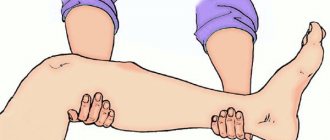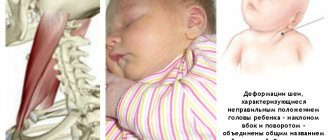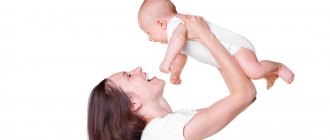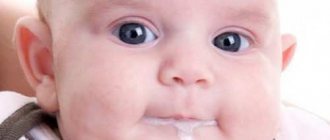What are innate reflexes? This is a special reaction of the baby to any external stimuli. Typically, the study of reflexes is used to examine the state of the child’s nervous system.
Each of the reflexes appears and disappears in a clearly defined period of time. Some reflexes can be seen almost from birth. Others appear only with age.
In a healthy child, all reflexes are symmetrical. The answer that can be observed is the same, both on the right and on the left. If a baby grasps objects well with one hand, but cannot do so with the other, this indicates developmental pathologies. A pediatrician will help you cope with this problem.
Basic innate reflexes of a newborn
Proboscis reflex.
If you lightly touch the child's lips, you can see the contraction of the mouth muscles - the child's lips are extended by the proboscis.
Search reflex.
If you lightly stroke the skin of the corners of a newborn's mouth, you can see how the baby's head turns towards the stimulus and the lower lip drops slightly. This reflex is called the search reflex. The child is trying to find his mother's breast. This reflex is especially noticeable before feeding. The reflex disappears only by 6-7 weeks.
Sucking reflex.
When you give your baby a pacifier, he begins to actively suck on it.
Babkin's palmo-oral reflex.
To see this reflex, just press your finger on the child’s palm where the thumb is. In response, the child will open his mouth and tilt his head slightly. This reflex completely disappears by 3-4 months. If the reflex remains at 5 months, you should contact your pediatrician.
Grasping reflex.
The baby should grasp the fingers placed in his palm. By 3-4 months the reflex disappears.
Moro reflex.
You need to sharply hit the table next to the child’s head on both sides of him. In response to this, the baby must first spread his arms to the sides, straightening his fingers, and then return his arms to the starting position. The reflex disappears by 4 months.
Protective reflex.
If you put your baby on his stomach, he turns his head to the side so as not to suffocate.
There are also other reflexes that are checked by obstetricians. Testing these reflexes allows us to determine whether there are any abnormalities or pathologies in the development of the newborn (in particular, those related to the formation of the central nervous system).
Grasp reflex in newborns
Every child has certain reflexes from birth. So, for example, sucking is the very first to appear - a couple of hours after birth, the baby is already actively eating mother’s milk. When should the grasping reflex develop in newborns, and what does its absence indicate?
When does it appear? It is important to understand that the presence or absence of reflexes allows us to judge the condition and development of the child. It should be taken into account that in children born ahead of schedule, reactions may develop a little later than usual - there is nothing wrong with this and this is a variant of the norm. Weak grasp reflex in newborns As a rule, a weak grasp reflex in newborns manifests itself almost from birth, and by two or three months they very firmly grasp everything that is offered to them: a hand, a finger, a toy. If this does not happen, then do not rush to get upset - perhaps the baby should get a little help. There is no grasping reflex in a newborn. If a newborn does not have a grasping reflex, then it is worth trying to develop it. To do this, you need to attract the child’s interest in the object being held out - it can be a bright, multi-colored toy. It is advisable to keep it just above the reach limit so that the child makes an effort to get what he wants. In addition, the cause of a weak or absent reflex can be muscle tone - a special massage will help eliminate it, which can be entrusted either to a specialist or performed independently. In combination with appropriate exercises, treatment will not take much time and soon the baby will be able to firmly grasp any objects. Reason to consult a doctor If there is a complete absence of the grasping reflex in newborns, despite all the exercises and stimulation, then this is a reason to consult a doctor. It may be necessary to prescribe additional drug treatment or a set of procedures that will help the child better control his body and develop basic skills. As a rule, if treatment is started in a timely manner, the recovery process occurs quite quickly and the child subsequently develops according to age standards. The grasping reflex in newborns appears from birth, and already after reaching 3 months of age, the baby with interest tries to grab everything he can reach. If the skill is weakly expressed or absent, then you should try to stimulate it on your own or consult a doctor to prescribe suitable treatment.
Sedative for newborns The problem when a newborn baby cannot calm down and fall asleep or regularly wakes up at night is by no means uncommon.
Yoga for newborns Regular physical exercises and activities for babies are a great way to help the baby in the full and timely development of all reflexes and systems.
Moro reflex in newborns A newborn comes into our world with a whole set of reflexes. Some of them were formed in the baby in the womb, others will help him survive outside...
Dec 04 2014 08:32 | Katerina in After Childbirth
Causes of poor development of reflexes
In some cases, reflexes develop with some delay. They may be inhibited and lethargic. All this is often caused by injuries during childbirth, is a response to medications or a consequence of illness. Weak grasping and oral reflexes are most often diagnosed in premature babies.
The reasons for the inhibition of reflexes can be pathologies of the baby’s development, dysfunction of the nervous system, the consequences of strangulation by the umbilical cord, etc.
The doctor will be able to assess the baby’s condition and develop a treatment methodology.
The grasp reflex, which is also known as the palmar reflex, is a primitive response that is present not only in human infants, but also in other primates. It can best be checked by stroking the baby's palm or placing an object in it.
Although this type of grip is quite strong, it is also very unpredictable - the child may unclench his fist without showing any warning signs.
In addition to the fact that this reflex helps the newborn to contact others, it is also one of the important parameters that determine the proper functioning and development of the nervous system.
These types of involuntary reflexes disappear on their own around six months of age; however, if the child does not outgrow them, it may indicate some developmental delays or damage to the nervous system.
When does the grasping reflex occur in children?
The grasp reflex is present in all newborns. It begins to develop in the womb and can occur sometime after 16 weeks of pregnancy.
How does the grasping reflex develop with age?
0-2 months
The baby is born with a grasping reflex, and this is easy to check. Stroke your baby's palm and he will immediately close his little fingers around yours.
These involuntary and instinctive movements are present until eight weeks after birth. During this time, you may notice that your baby may begin to open and close their fists. The baby may begin to grab softer objects.
3 months
At three months of age, a baby may still struggle to grasp or hold objects. There is no need to worry as this is quite normal.
At this age, the child develops better hand-eye coordination: he will try to reach various objects that may be placed or are within his reach.
An excellent way to exercise your child's grasping reflex is a developmental mat. Lying on a flat surface, the baby will try to catch various hanging objects.
4-8 months
At this stage, the baby is better able to hold large objects such as building blocks. However, he still needs to get used to small objects. And when his first tooth appears, the baby will begin to pull out everything that gets into his mouth.
The baby can move objects from one hand to another. It's time to take care of safety, if you haven't done so before - remove small objects away from the child.
9-12 months
At this age, the child can already lift objects with the least amount of effort. His grip is constantly improving, which means he will be able to lift smaller objects.
Thanks to improved hand-eye coordination, the child learns to hold a spoon in his hands. However, he may still prefer his fingers to put food in his mouth.
When does grasping reflexnoix disappear?
The grasp reflex begins to disappear by the time the baby reaches 2-3 months.
This reflex in newborns promotes the development of voluntary reflexes, and if it is absent, it may indicate some type of motor nerve damage or injury or neurological defect such as cerebral palsy.
How can you stimulate the grasping reflex in a child?
Here are some things that will help develop your baby's grasping reflex:
- Try placing bright objects around your child. You can place them slightly out of your baby's reach, thereby encouraging him to move.
- Place objects such as blocks, rings, rattles, etc. within close proximity of the baby so that he can reach them. Don't put them too far away - this will only irritate him.
- As your baby develops a better finger grip, you can encourage him to hold food items this way. Boiled carrots, peas, etc. are suitable for this.
When should you worry?
The following situations may be of concern:
- if the child cannot grab the object that is in front of him;
- if the child is unable to lift or attempts to grasp an object by the time he is three or four months old.
However, if the baby was born prematurely, his development may lag slightly behind his peers.
The grasp reflex is one of many reflexes such as sucking, Moro, stepping, asymmetrical tonic neck reflex, etc. All of them are important for the healthy development of the child. However, if such reflexes are absent or appear late or weak, this may be due to certain diseases, medications or trauma during childbirth.
Stages of development of the grasping reflex
As soon as the baby learns to hold objects, he will immediately be able to get into the wonderful world of the game. The first conscious grasping reflex will be the first steps towards independent eating, drawing, reading, writing skills, and generally independent actions.
How does the grasping reflex develop?
Newborns have an innate grasp reflex . But in order for it to become conscious and the child’s movements become more coordinated, it will take about a year . Starting from three months of life, the grasping reflex develops more and more intensively, and the child begins to make great strides with each new month.
Stages of development of the grasping reflex
From birth to 2 months
As mentioned earlier, babies are born with a grasping reflex. If you press your finger on your newborn baby's palm, he will definitely close his palm around it. But this movement is still instinctive and unconscious. Most of the time, your baby's hands will be clenched into small fists. But soon the newborn baby will begin to show curiosity and will open and close them. This is how his first explorations of himself will begin. It is very possible that your child will try to grab something that is freely available.
Three months
Your child still doesn’t quite understand what he really wants, but he will always show joyful animation when he sees his first toys . By trying to take possession of an object of interest to him, the baby thereby develops his eyes and hand coordination. Hang a mobile with toys . He will definitely look at them and try to reach them. the game “peek-a-boo” with him , lightly covering his face with a diaper. Once he sees you removing the fabric from his face, he will eventually try to remove it on his own.
From 4 to 8 months
During this time period, it is worth taking care of the safety of your baby . Remove all toys with small parts from his free access. They may turn out to be unsafe. Closer to 8 months, the child will already learn to hold objects quite well . But he will still lack a certain agility.
Shortly before the baby's first tooth appears (usually between the third and twelfth month), he will begin to pick up objects in his hands and then drag them into his mouth . If your baby is already eating his first complementary foods , then you can give him a baby spoon to play with. Since babies begin to crawl between 5 and 8 months, all fragile or valuable things in the house need to be put away higher up.
From 9 to 12 months
there is no problem for your baby to grab this or that thing with his right or even left hand. At this age, the difference in the left and right hands is completely unimportant for the child. They simply don't exist yet. Only by the age of two will it become clear whether your baby is right-handed or left-handed . The child’s hands have become quite tenacious and strong, so with some effort you will have to take the forbidden thing from his little hands.
What happens next?
The yearling's favorite pastime will be throwing toys. He will get great pleasure from throwing a toy and waiting for you to pick it up and give it to him so that he can throw it again. So be patient.
At the age of two years, will awaken in the baby . And then beware of wallpaper, walls and floors! Felt pens, brushes and paints, wax crayons and pencils - all this will arouse great interest in the baby.
At three years old, coordination will become so good that the child will be able to put his signature , even if it is very clumsy.
Parents' task
To stimulate your baby's grasping reflex , place a colorful and interesting toy out of her reach, but so that your baby can grab it with a little effort. Encourage him to do this. In order to develop his fingers, offer him modeling from plasticine, give him an apple, chopped carrots, a crust of bread , etc. By doing this, you will not only help develop your child’s fine motor skills, but also promote speech development .
When should you be concerned?
If you see that the baby is interested in an object, but he does not try to grab it , even if you hold it in front of his nose, then this is a reason to consult a doctor. Or, when he reached 9 months, he still hasn’t learned to grab and hold objects , then this is also a reason to discuss this problem with a doctor.
Keep in mind that in premature babies, the stages of development of the grasping reflex are slightly shifted from those given in the article.
Reflex tracking in infants
Clear tracking of this reflex occurs while the child is sleeping by creating a sharp noise. According to experts, the child gets a slight fright in this state. The baby does not like this condition and begins to cry.
Children must have an innate reflex. If the Moro reflex is absent in newborns, we can think about the presence of serious causes in children. Maybe:
- the meninges received hemorrhage;
- have cerebral palsy;
- swelling of the brain or the presence of other unpleasant diseases.
If the newborn does not respond, it means that he has suffered an intracranial injury. If the reflex appears spontaneously, we can assume that the child is developing normally.











